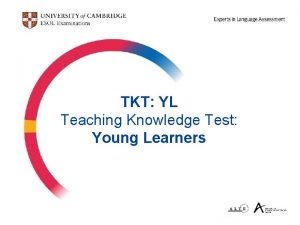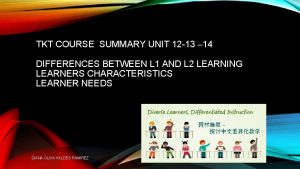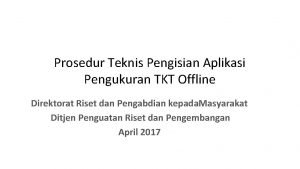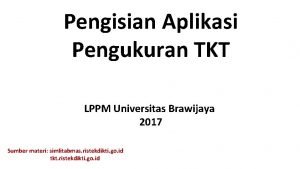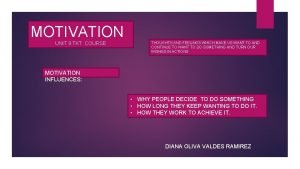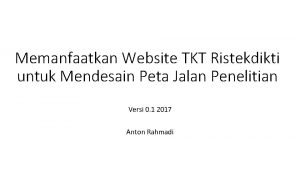TKT COURSE SUMMARY UNIT 12 13 14 DIFFERENCES










- Slides: 10

TKT COURSE SUMMARY UNIT 12 -13 – 14 DIFFERENCES BETWEEN L 1 AND L 2 LEARNING LEARNERS CHARACTERISTICS LEARNER NEEDS DIANA OLIVA VALDÉS RAMÍREZ

DIFFERENCES BETWEEN L 1 AND L 2 LEARNING LEARNERS CHARACTERISTICS • When we learn our first Language (L 1) we are likely to learn it in a different context and in a different ways from when we learn a second language (L 2) • Learners characteristics, include a learner’s motivation, learning style, learning strategies, maturity and past language learning experiences, how they learn it, how they respond to different teaching styles and approaches in the classroom, and how succesfully they are at learning a language.

AGE L 1 LEARNING L 2 LEARNING (in the classroom) Learning starts when the learner is a baby and continues through his life. Usually starts in primary school and / or secondary and continue in adulthood. Babies learn language at the same time as their cognitive skills (the mental processes involved in thinking, understanding or learning) develop. Primary learners are still developing many of their cognitive skills Secondary school learners may or may not be mature about their attitudes toward learning the foreign language. Adult learner show maturity in their attitudes to language learning. Learners are motivated to learn Adult and some secondary learners language as they need to communicate. may already have expectations (beliefs that something will or should happen) about how languages should be learnt

Context and ways of learning L 1 LEARNING L 2 LEARNING (in the classroom) By exposure to and picking up language, hearing the language. By been taught specific language ítems Focusing on structures and individual words. By learning a lot of language in Chunks By wanting and needing to communicate, strong motivation. Through Interaction with family. With strong, Little or no motivation to communicate Through interaction with a teacher. Talking and doing things about their surrounding. By listening to, taking a silent period before using the language. By playing, experimenting, having lots of opportunities to experiment with language. By getting lots of praise and encouragement for using the language. By hearing simplified speech. Often by talking about life outside the classroom. Often by needing to produce language after it has been taught. Using language in controlled practice activities Playing and experimenting with new language. Learners are not exposed to the L 2 very much. Teachers vary in the amount of praise or encouragement they give learners. Teachers usually simplify the language they use. Teachers often correct learners. They may or may not be given opportunities to make mistakes and experiment.

LEARNING STYLES • Are the ways in which a learner naturally prefers to take in, process and remember information and skills. Our learning style influences how we like to learn and how we learn best. Experts have suggested several different ways of classifying learning styles. • They relate to the physical sense we prefer to use to learn, our way of interacting with other people and our style of thinking. Here are some commonly mentioned learning styles.

LEARNING STRATEGIES • Are the ways that learners choose and use to learn language. They include ways to help themselves identify what they need to learn, process, remember, and use new language. Using the right strategy can help to make us more able to learn without depending on the teacher. i. e. to become more independent or autonomous learners. EXAMPLES LEARNING STRATEGIE S Repeating new words In your head Experimenting /talking risks by using just-learnt language. Asking teacher to give you feedback on your language use. Deciding to use the foreign language as much as possible Recording yourself speaking, then correcting Asking a speaker to repeat what he said Deciding what area of vocabulary need to learn and then learning it Thinking about how to memorise all the words you meet each class, Paraphrasing CHILDREN “Each age group generally needs to be taught in different ways. ” ADULTS Another characteristics which can vary from learner to learner has to be with their personality, shy, outgoing, patient, curious, sensitive and will afect how and how much each learner engages in different kinds of activities Need to move Can concentrate for shorter periods Learn through experience and doing, are not very able to control and plan their own behavior Are not afraid of making mistakes. Pay attention to meaning in language Have limited experience of life Motivation is a way to communicate and learn MATURITY TEENAGERS Starting to keep still for longer periods but still need to move, concentration developing Beginning to learn in abstract ways, (thinking and experiencing) Beginning to control and plan their own behavior may worry about what others think of them Pay attention to meaning an increasingly to form Congnitive skills believed to be developed around age 15. motivation varies. Able to keep still for longer periods. Can concentrate for longer periods can learn in more abstract ways Usually able to control and plan their own behavior May not be so willing to make mistakes or take risks. Aware of themselves and/or their actions , can pay attention to form and meaning in language, have experience life, have mature cognitive skills. , Motivation conscious and controlled.

KEY CONCEPTS • Teachers may become aware of their own learning styles and compare this with how they teach. • We can find our learners’ characteristics, asking them observing them, giving them questionnaires, asking at the end of a lesson • We can train learners to become aware of and use different learning strategies. This is part of Learner training. • Teachers may need to change their teaching to make the learners more comfortable and confident • Teachers can build into their lessons activities which match different learning styles. • When teachers consider their learners´ maturity it will strongly influence their lesson planning and what they do in the classroom. • It is not possible for the teacher to match the learner characteristics of each learner all the time. Across a number of lessons teachers can try to vary how they teach.

LEARNERS NEEDS • A learner of a foreign language has various kinds of needs which influence his/her learning. Recognizing and trying to meet learner needs are part of being a good teacher. LEARNER NEEDS Kind of needs Reason for needs Personal needs, e. g. security, challenge support, praise, movement, goals learning expectactions Age, gender, cultural background, interests, educational background, motivation, personality Learning needs e. g. specific target language, specific language subskills, exam strategies, learner autonomy, working at a suitable level Learning styles Past language learning experience, learning gap (gap between the learner’s present level and the target level of language proficiency) learning goals and expectations, level of skill and knowledge, availability of time exams Future) Professional needs e. g. specific subskills, specific vocabulary and grammar, specific functions, specific text types Professional language requirements for employment, training education.

KEY CONCEPTS • TEACHING LANGUAGE CLASSROOM • Content and Language Integrated Learning (CLIL) courses for students needing to learn another subject in another language. Meeting learners’ needs helps to motivate learners, making the course more relevant t them. • Adults or older teenagers with specific professional, general or academic goals for learning English need courses that meet their needs. • This courses vary in length, frequent, class size, language skill focused on, type of English, teaching methods and activities LEARNER NEEDS How the teacher can address learners’ needs Personal needs Choosing a suitable: § Material and topics § Approach to teaching (e. g activity-based or topic-based learning) § Pace (speed of lessons) § Treatment of individual learners § Skills and language § Interaction patterns (e. g. whole class, group, pair or individual work) § Types of feedback (comments or learning) Learning needs Choosing a suitable: § Materials and topics § Approach to teaching and assessment. § Activities § Interaction patterns § Language and skills § Level of language and skills § Learning strategies § workload

